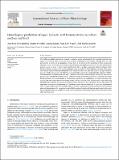Por favor, use este identificador para citar o enlazar a este item:
http://hdl.handle.net/10261/274996COMPARTIR / EXPORTAR:
 SHARE SHARE
 CORE
BASE CORE
BASE
|
|
| Visualizar otros formatos: MARC | Dublin Core | RDF | ORE | MODS | METS | DIDL | DATACITE | |

| Título: | Heterologous production of equol by lactic acid bacteria strains in culture medium and food |
Autor: | Ruiz de la Bastida, Ana; Peirotén, Ángela; Langa, Susana; Arques Orobón, Juan Luis; Landete, José María CSIC ORCID | Palabras clave: | 5-Hydroxy-equol Equol Health Lactic acid bacteria Lactobacilli |
Fecha de publicación: | 10-nov-2021 | Editor: | Elsevier | Citación: | International Journal of Food Microbiology 360: 109328 (2021) | Resumen: | The isoflavones daidzin and genistin, present in soybeans, can be transformed by the intestinal microbiota into equol and 5-hydroxy-equol, compounds with enhanced availability and bioactivity, although these are only produced by a fraction of the population. Hence, there is an interest in the production of these compounds, although, to date, few bacteria with biotechnological interest and applicability in food have been found able to produce equol. In order to obtain lactic acid bacteria able to produce equol, the daidzein reductase (dzr), dihydrodaidzein reductase (ddr), tetrahydrodaidzein reductase (tdr) and dihydrodaidzein racemase (ifcA) genes, from Slackia isoflavoniconvertens DSM22006, were cloned into the vector pNZ:TuR, under a strong constitutive promoter (TuR). Lactococcus lactis MG1363, Lacticaseibacillus casei BL23, Lactiplantibacillus plantarum WCFS1, Limosilactobacillus fermentum INIA 584L and L. fermentum INIA 832L, harbouring pNZ:TuR.tdr.ddr, were able to produce equol from dihydrodaidzein, while L. fermentum strains showed also production of 5-hydroxy-equol from dihydrogenistein. The metabolization of daidzein and genistein by the combination of strains harbouring pNZ:TuR.dzr and pNZ:TuR.tdr.ddr showed similar results, and the addition of the correspondent strain harbouring pNZ:TuR.ifcA resulted in an increase of equol production, but only in the L. fermentum strains. This pattern of equol and 5-hydroxy-equol production by L. fermentum strains was also confirmed in cow's milk supplemented with daidzein and genistein and incubated with the different combination of strains harbouring the constructed plasmids. Bacteria generally recognized as safe (GRAS), such as the lactic acid bacteria species used in this work, harbouring these plasmids, would be of value for the development of fermented vegetal foods enriched in equol and 5-hydroxy-equol. | Descripción: | Departamento de Tecnología de los Alimentos | Versión del editor: | https://doi.org/10.1016/j.ijfoodmicro.2021.109328 | URI: | http://hdl.handle.net/10261/274996 | DOI: | 10.1016/j.ijfoodmicro.2021.109328 | ISSN: | 0168-1605 | E-ISSN: | 1879-3460 |
| Aparece en las colecciones: | (INIA) Artículos |
Ficheros en este ítem:
| Fichero | Descripción | Tamaño | Formato | |
|---|---|---|---|---|
| Heterologous-production-of-equol-by-lactic-acid-bacteria.pdf | artículo | 499,17 kB | Adobe PDF |  Visualizar/Abrir |
CORE Recommender
PubMed Central
Citations
4
checked on 30-abr-2024
SCOPUSTM
Citations
14
checked on 28-abr-2024
WEB OF SCIENCETM
Citations
14
checked on 27-feb-2024
Page view(s)
41
checked on 03-may-2024
Download(s)
57
checked on 03-may-2024



